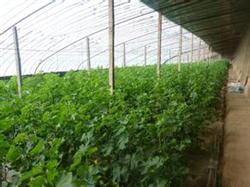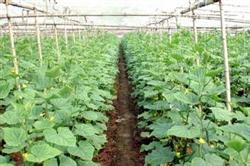Cucumber seedling in winter and spring

When cucumber seedlings are raised in greenhouse in winter and spring, the temperature is low, and if there is a little improper application of watering or temperature and humidity management, it is very easy to cause cucumber seedling rot, root burning, root retting, disease and death of seedlings, and measures must be taken to prevent and control them. If you encounter continuous rain or heavy snow after sowing, the humidity of the bed soil is high, and the emergence of seedlings is delayed, which is easy to cause rotten seeds. The prevention and control measures are to raise seedlings in a hot bed or hot wire hotbed in the cold air to increase the temperature in the greenhouse, or to increase the temperature by multi-layer mulching or heating with hot fire, and then sow seeds after the temperature of the seedbed rises. The application of immature organic fertilizer or uneven fertilization or excessive application of mineral fertilizer in the anti-root-burning seedbed is easy to burn roots when the soil moisture is insufficient. The leaves and growth points of root-burning seedlings were wrinkled, the roots were yellow and thin, and the whole plant wilted when it was serious. The prevention and control measure is to apply rotten and finely crushed organic fertilizer in the seedling bed and mix it well with the bed soil. Less application of nitrogen fertilizer, found that root burning should also be watered in time. When the soil moisture of anti-retting root bed is more than 90% and the temperature is lower than 10 ℃, the respiration and water absorption capacity of cucumber roots are greatly weakened, and retting roots often occur. The leaves of the seedlings of retting roots are wilting and the roots are yellow and rotten. The prevention and control measure is to uncover the mulch on a sunny day, spread a layer of fine dry soil or plant ash evenly to the bed surface, and cover it strictly immediately, which can not only reduce the humidity of the bed soil, but also increase the temperature. The main disease of disease control cucumber in seedling stage is quenching disease. The suitable soil temperature for pathogen reproduction is about 15 ℃, and it is easy to occur at high humidity and low temperature in seedling bed. Waterlogged dark disease spots were produced at the base of the embryo stem of the damaged seedlings, which continued to expand around the stem, and finally contracted into linear quenching. The prevention and control measure is to strengthen the temperature and humidity management of the seedbed and reduce the incidence of the disease. Ventilating and training seedlings in time after emergence in order to improve the disease resistance of melon seedlings. It is found that the diseased plant is removed in time, and 70% pentachloronitrobenzene and 80% Dysen zinc powder are mixed in the same amount, and 10 grams per square meter of seedling bed can effectively prevent the occurrence of the disease.
- Prev

Management skills of cucumber in shed after Spring Festival
Manage the fertilizer and water well in the middle and late February, most greenhouse cucumbers enter the peak period of melon production, and the demand for fertilizer and water also increases gradually. therefore, cucumber topdressing should be carried out after the end of February. Generally, urea 20 kg, potassium dihydrogen phosphate 5 kg 8 kg or potassium sulfate compound fertilizer 30 kg 35 kg is applied every 15 ha, and 1 every 20 days.
- Next

Multi-layer mulching Seedling technique of Cucumber in Spring greenhouse
First, do not change the light angle of the greenhouse at will. At present, the angle of the solar greenhouse in which cucumber is cultivated has been scientifically demonstrated for a long time, and its north-south span, height and back slope angle should not be changed at will. Second, avoid centralized fertilization when planting. All kinds of chemical fertilizers, especially nitrogen fertilizers, will produce a large amount of nitrogen fertilizer at high temperature and humidity.
Related
- Where is it suitable to grow horseradish in China? it is expected to see the middle altitude horseradish in Alishan.
- How to prevent tomato virus disease reasonably? (Control methods included)
- Many people like to plant towel gourd on the balcony. What are the main points of this method and management?
- What crops can chili peppers be mixed with?
- Fertilization techniques and matters needing attention in Tomato
- What are the grafting techniques for peach seedlings in spring?
- Harm and control methods of root swelling disease of Chinese cabbage
- What are the pests of sweet potatoes? How to prevent and cure it?
- Symptoms, causes and Control methods of navel Rot in Tomato
- The cause of "Cucumber rotten bibcock" in Farmers' planting Cucumber and its Control Plan

